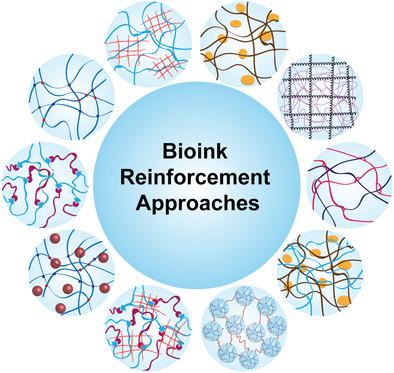当前位置:
X-MOL 学术
›
Adv. Mater.
›
论文详情
Our official English website, www.x-mol.net, welcomes your
feedback! (Note: you will need to create a separate account there.)
Hydrogel Bioink Reinforcement for Additive Manufacturing: A Focused Review of Emerging Strategies.
Advanced Materials ( IF 27.4 ) Pub Date : 2019-10-10 , DOI: 10.1002/adma.201902026 David Chimene 1 , Roland Kaunas 1 , Akhilesh K Gaharwar 1, 2, 3
Advanced Materials ( IF 27.4 ) Pub Date : 2019-10-10 , DOI: 10.1002/adma.201902026 David Chimene 1 , Roland Kaunas 1 , Akhilesh K Gaharwar 1, 2, 3
Affiliation

|
Bioprinting is an emerging approach for fabricating cell-laden 3D scaffolds via robotic deposition of cells and biomaterials into custom shapes and patterns to replicate complex tissue architectures. Bioprinting uses hydrogel solutions called bioinks as both cell carriers and structural components, requiring bioinks to be highly printable while providing a robust and cell-friendly microenvironment. Unfortunately, conventional hydrogel bioinks have not been able to meet these requirements and are mechanically weak due to their heterogeneously crosslinked networks and lack of energy dissipation mechanisms. Advanced bioink designs using various methods of dissipating mechanical energy are aimed at developing next-generation cellularized 3D scaffolds to mimic anatomical size, tissue architecture, and tissue-specific functions. These next-generation bioinks need to have high print fidelity and should provide a biocompatible microenvironment along with improved mechanical properties. To design these advanced bioink formulations, it is important to understand the structure-property-function relationships of hydrogel networks. By specifically leveraging biophysical and biochemical characteristics of hydrogel networks, high performance bioinks can be designed to control and direct cell functions. In this review article, current and emerging approaches in hydrogel design and bioink reinforcement techniques are critically evaluated. This bottom-up perspective provides a materials-centric approach to bioink design for 3D bioprinting.
中文翻译:

用于增材制造的水凝胶生物油墨增强:新兴策略的重点回顾。
生物打印是一种通过将细胞和生物材料自动沉积为自定义形状和图案以复制复杂组织架构的方法来制造载有细胞的3D支架的新兴方法。生物打印使用称为生物墨水的水凝胶解决方案作为细胞载体和结构组件,要求生物墨水具有高度可打印性,同时提供强大且对细胞友好的微环境。不幸的是,常规的水凝胶生物油墨不能满足这些要求,并且由于它们的异质交联网络和缺乏能量耗散机制而在机械上较弱。使用各种耗散机械能的方法进行的高级生物墨水设计旨在开发下一代细胞化3D支架,以模仿解剖学尺寸,组织结构和组织特定功能。这些下一代生物油墨需要具有高印刷保真度,并应提供生物相容的微环境以及改善的机械性能。要设计这些先进的生物墨水配方,重要的是了解水凝胶网络的结构-性能-功能关系。通过特别利用水凝胶网络的生物物理和生化特性,可以设计出高性能的生物墨水来控制和指导细胞功能。在这篇综述文章中,对水凝胶设计和生物墨水增强技术的当前和新兴方法进行了严格的评估。这种自下而上的观点为3D生物打印提供了以材料为中心的生物墨水设计方法。要设计这些先进的生物墨水配方,重要的是了解水凝胶网络的结构-性能-功能关系。通过特别利用水凝胶网络的生物物理和生化特性,可以设计出高性能的生物墨水来控制和指导细胞功能。在这篇综述文章中,对水凝胶设计和生物墨水增强技术的当前和新兴方法进行了严格的评估。这种自下而上的观点为3D生物打印提供了以材料为中心的生物墨水设计方法。要设计这些先进的生物墨水配方,重要的是了解水凝胶网络的结构-性能-功能关系。通过特别利用水凝胶网络的生物物理和生化特性,可以设计出高性能的生物墨水来控制和指导细胞功能。在这篇综述文章中,对水凝胶设计和生物墨水增强技术的当前和新兴方法进行了严格的评估。这种自下而上的观点为3D生物打印提供了以材料为中心的生物墨水设计方法。在这篇综述文章中,对水凝胶设计和生物墨水增强技术的当前和新兴方法进行了严格的评估。这种自下而上的观点为3D生物打印提供了以材料为中心的生物墨水设计方法。在这篇综述文章中,对水凝胶设计和生物墨水增强技术的当前和新兴方法进行了严格的评估。这种自下而上的观点为3D生物打印提供了以材料为中心的生物墨水设计方法。
更新日期:2020-01-07
中文翻译:

用于增材制造的水凝胶生物油墨增强:新兴策略的重点回顾。
生物打印是一种通过将细胞和生物材料自动沉积为自定义形状和图案以复制复杂组织架构的方法来制造载有细胞的3D支架的新兴方法。生物打印使用称为生物墨水的水凝胶解决方案作为细胞载体和结构组件,要求生物墨水具有高度可打印性,同时提供强大且对细胞友好的微环境。不幸的是,常规的水凝胶生物油墨不能满足这些要求,并且由于它们的异质交联网络和缺乏能量耗散机制而在机械上较弱。使用各种耗散机械能的方法进行的高级生物墨水设计旨在开发下一代细胞化3D支架,以模仿解剖学尺寸,组织结构和组织特定功能。这些下一代生物油墨需要具有高印刷保真度,并应提供生物相容的微环境以及改善的机械性能。要设计这些先进的生物墨水配方,重要的是了解水凝胶网络的结构-性能-功能关系。通过特别利用水凝胶网络的生物物理和生化特性,可以设计出高性能的生物墨水来控制和指导细胞功能。在这篇综述文章中,对水凝胶设计和生物墨水增强技术的当前和新兴方法进行了严格的评估。这种自下而上的观点为3D生物打印提供了以材料为中心的生物墨水设计方法。要设计这些先进的生物墨水配方,重要的是了解水凝胶网络的结构-性能-功能关系。通过特别利用水凝胶网络的生物物理和生化特性,可以设计出高性能的生物墨水来控制和指导细胞功能。在这篇综述文章中,对水凝胶设计和生物墨水增强技术的当前和新兴方法进行了严格的评估。这种自下而上的观点为3D生物打印提供了以材料为中心的生物墨水设计方法。要设计这些先进的生物墨水配方,重要的是了解水凝胶网络的结构-性能-功能关系。通过特别利用水凝胶网络的生物物理和生化特性,可以设计出高性能的生物墨水来控制和指导细胞功能。在这篇综述文章中,对水凝胶设计和生物墨水增强技术的当前和新兴方法进行了严格的评估。这种自下而上的观点为3D生物打印提供了以材料为中心的生物墨水设计方法。在这篇综述文章中,对水凝胶设计和生物墨水增强技术的当前和新兴方法进行了严格的评估。这种自下而上的观点为3D生物打印提供了以材料为中心的生物墨水设计方法。在这篇综述文章中,对水凝胶设计和生物墨水增强技术的当前和新兴方法进行了严格的评估。这种自下而上的观点为3D生物打印提供了以材料为中心的生物墨水设计方法。











































 京公网安备 11010802027423号
京公网安备 11010802027423号